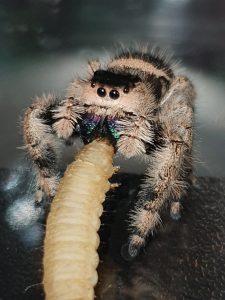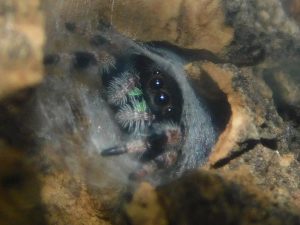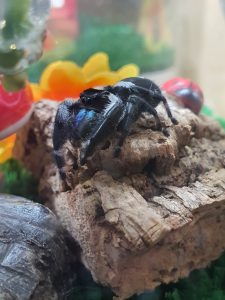Phidippus regius
Common Name: Jumping spider, Regal jumping spider
Scientific Name: Phidippus regius
Native to: North America, Florida, Bahamas, Cuba and Jamaica
Life Span: Males 1 – 2yrs & Females 1 – 3yrs
Size: Varies greatly for each individual, as little as 5mm to as big as 25mm
Temperament: Generally docile, some can be skittish but rarely bite for no reason
Appearance: Males are usually black with white markings and green/blue chelicerae Females vary in colour from light tan to dark brown with blue/purple or pink chelicerae
other types such as Phidippus regius white Bahamas can be white or grey in colour and Phidippus regius Apalachicola and bahamas have little white ear muffs, Phidippus from different regions can produce varying colours.
Enclosure type: Secure, with cross ventilation and either bottom or front opening
Enclosure size: 25cm x 15cm x 15cm is adequate for an adult however bigger is enjoyed
Temperature: Day 22°C – 26°C & Night 20°C – 22°C
Humidity: Misting the enclosure every other day, every day in the summer, is enough to provide regular humidity and hydration, avoid spraying the spider directly or creating large waterdrops in which they could drown.
About:
Phidippus regius jumping spiders are one of the most common species of jumping spider kept as pets, with its cute little fluffy face and big eyes they are super easy to love and don’t take up much space, unlike some of our typical exotic pets. Arachnophobes are turning to these small spiders to ease their fears and photographers to work with their macro lens. The jumping spider from the Salticidae family is known for its ability to jump from place to place and build adorable little hammocks to sleep and moult in.
Smaller than the usual pet tarantula these guys do well in a huge variety of enclosure these can be customised and personalised to the owners preference, they are easy to handle and can be super friendly, they very rarely bite un provoked, the small amount of venom they have is not harmful to humans (unless allergic) should you be bitten generally it causes very little irritation if any (sometimes compared to a bee sting). These fluffy spiders maybe small but full of character, easy to keep and unbelievably photogenic.
Housing:
There is a huge number of options available for housing Jumping spiders, from household Tupperware conversions to micro tanks and specialised acrylic tanks. These can be plastic, easy to clean, personalised creations with fake plants and ornaments or they can be bioactive, more natural looking substrate based with moss and bark etc. each type has pros and cons it is down to each keeper’s preference. What’s important with every enclosure is cross ventilation, this can be achieved by creating a number of tiny holes in the sides of the enclosure or by fixing large vents into the bigger enclosures. Slings (spiderlings) of this species are very small and usually rehomed at the 4th instar which is still very tiny around 5mm in size these little slings need to be kept in a much smaller enclosure to allow them to find food with ease and maintain a good humidity for the earlier moults. Some breeders such as ourselves provide a temporary grow on enclosure in the form of a disposable smoothie cup, it has a dome lid, an area for a small vent on top and is clear for good viewing, no holes for the tiny fruit flies to escape and the dome allows for hammock building that isn’t disturbed when opening, an ideal starting point for young slings. After a few moults they will be big enough to go into a larger permanent enclosure that has the necessary ventilation for less fragile, more experienced bigger jumping spiders.
Decoration & Substrate:
Decoration is purely aesthetic and for the benefit of the owner, there is a number of homemade enclosures available to buy online, these range from themed Disney ones to gorgeous little dolls house rooms with bookshelves. Others opt for the more natural bioactive style enclosure, decorating with sticks and bark, leaf litter and rocks, all of which make for good homes for your jumping spider. A few things to keep in mind though, the latest trend of using magnetic hidey houses or silk cocoon nests is cute but potentially dangerous to your pet, unfortunately I have seen a fair few falling accidents on social media with these, whether its because the wrong/cheap glue was used or because the magnet has been knocked or was not strong enough so please be aware it can be fatal, cheap hot gun glue loses its strength with humidity and other glues can be toxic. If you choose to use one of these little hides please make sure its well made or adapt it by tying it to something, make it safe in a way that it won’t crush or drop your little jumping spider. Sticks are great for decorating your enclosure as it gives height and access to higher areas of the enclosure, these little jumpers love that. Not all wood is spider safe, generally wood such as oak, beech and Alder are safe, to name a few, all naturally sourced sticks and leaves should be sterilised to remove any unwanted pests, this can be done by freezing for a few days (longer for thicker items), microwaving for a few minutes or baking for a long period of time.
Substrate is also down to the preference of the keeper, I have used artificial grass and coco coir/soil mix I’ve also used moss, they each have pros and cons, keep in mind that these spiders can be clumsy and when elderly, wobbly. Falling unfortunately happens, a soft substrate at the bottom of the enclosure will help protect against injury, a hard base such as lino or paper towel doesn’t offer a soft landing, coco coir/ soil mix holds humidity better than an artificial base however this has never been an issue for us when used alongside daily misting, I much prefer the use of coco coir/soil mix or moss for slings when in the grow on cups or small enclosures, it helps with the humidity in the fragile stages, absorbs larger water droplets should you accidently over mist and gives a soft landing should they fall when learning to jump or during moult, artificial grass is also soft and bouncy, easy to clean and comes in an array of colours.
Heating:
different breeders keep these little spiders at various temperatures but generally the rule of thumb is Day time temps of 22°C – 26°C and night time temps of 20°C – 22°C they can tolerate temps up to 30°C but it is said to speed up maturity and therefore shorten their lifespan which I think is unfairly short enough. The average household temps in the UK of a heated house is around 20°C to 22°C, these temperatures are tolerable and extra heating isn’t necessary, if however you have a colder house especially in the winter months the additional heat source is a must, this can be provided in the form of a heat mat attached to the wall or unit behind your enclosure(s) and must be used with a thermostat, normally the mats would be used under an enclosure as it is with reptiles however the mat would struggle to penetrate the substrate and then raise the ambient temp enough to reach your spider perched in the hammock at the top so they tend to be used behind the enclosure. A good way to do this if you keep a few spiders or mantis etc on a shelf unit is to attach a large mat on the back of the shelf unit (if the back is thin ply) heat lamps are also an option but are a bit over the top for a single spider as the give off a large amount of heat, either way, no matter the source they must be used with a thermostat. As with most exotic species these spiders benefit from a small temperature drop at night time just as you would see naturally in the wild.
Lighting:
Jumping spiders have very good eyesight especially in good light and seem to thrive when kept in a nice brightly lit room, direct sunlight whilst enclosed can and will kill most pets and is definitely not recommended but indirect sunlight is very much appreciated, many spiders on the social media groups that have had problems with not eating have made a huge turn around with the simple introduction of lighting, it helps them to hunt and play if they can see well. We use an led strip lighting set up on every shelf of our units so that all of our little jumpers can be seen and can see really well and it makes for some great photo shoots, this is on a timed system so the lights go out at bed time.
Feeding:
For the most part these little spiders are good eaters, they are capable of taking down prey bigger than themselves however it can be a bit overwhelming for them and best to stick to a suitable sized prey. Young slings feed really well on flightless fruit flies such as D.melanogaster these are the smallest flies widely available, they come in a culture of food and will feed, breed and rebloom after a while, these can last a few weeks, feeding a sling about 3 of these every 3 days is ideal. D hydei flightless fruit flies are the next size up and are perfect for moving up the prey size, any good breeder will have already got the sling on to this size before rehoming, not only that but the cannot harm your slings unlike some other feeder insects so it is safe to leave these in the enclosure. Once your spider is 10mm + in size they could manage a green bottle fly, these are a great staple, these can be purchased as casters/pupae, you can keep these in the fridge to slow down the hatching process and get out a few at a time. You keep these warm for a week in order to hatch and feed them just as you can with a house fly and blue bottle fly caster which are the next two sizes available for adult spiders, just remember that the casters can take 4 to 14 days to hatch depending on temperatures. We also offer our spiders very small locust, wax worm moths, wax worms and meal worms on occasions too, its best to squish the head of a wax worm or meal worm if your spider takes it bottom end first as they have been known to turn and bite the spider, some keepers feed crickets as these are cheap and come in various sizes but be aware that these carry the most parasites of all the feeders and are generally not considered a good feeder source. Fussy, elderly and nervous spiders can be encouraged to eat by offering a bit of chopped up mealworm, waxworm or a squished caster.
Sexing:
Sexing the Phidippus reguis species of jumping spider is usually, but not always straight forward, what I mean by that is an adult male is black with white markings and green or blue chelicerae ( kel is er ray) the coloured fang coverings on the mouths parts, this is pretty much the same rule for all Phidippus males, and usually obvious in slings after the first 4/5 moults or i4/i5.
Females as adults vary in colour from orange, reddish browns to grey and white but generally a lot lighter than the males, with their chelicerae being pink, purple and sometimes orange or gold in colour, however as slings these are not always as obvious to sex, or ones that look a bit lighter, moult and then are actually male with male colours as they get older, I currently have an i6 sling that is very light brown and white in the body but has bright green chelicerae, on occasion you do see females with green chelicerae so these are most definitely not a guaranteed way to sex this species, in fact the only way to sex this species 100% is to see them to maturity, after the last moult the males will own a nice pair of boxing glove shaped pedipalps where as the females will have slimmer but fluffy pedipalps and the underside of her will now show the epigynum (epi gin um), a small shiny opening located in the upper midsection of the abdomen just behind the book lungs.
Other species of Phidippus such as Phidippus audax for example show virtually no sexually dimorphic signs until sub/adult.
If you have any questions are not answered here, please feel free to contact us either through our Facebook – @arunaexo, Instagram – aruna_exotics or email – info@aruna-exotics.com








